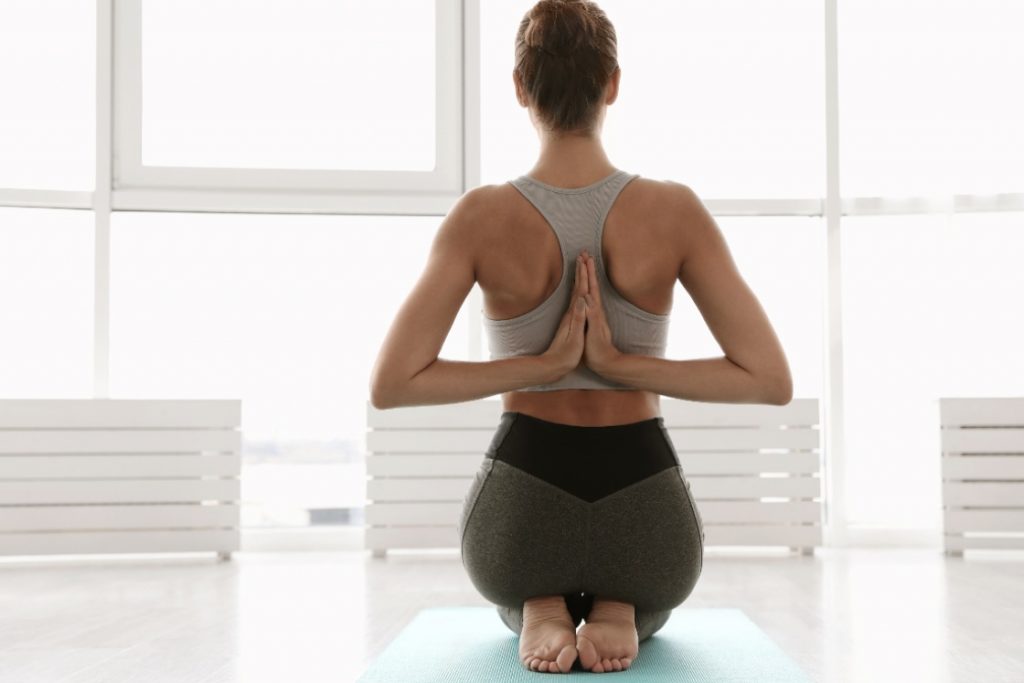
| Sanskrit Pronunciation | Vajrasana (vahj-rah-suh-nuh) |
| Meaning | Vajra – Firm or diamond-like Asana – Pose |
| Pose Type | Sitting |
| Pose Level | Beginner, sit 1 to 2 minutes |
| Beneficial In | Digestion, strengthening ankles, and lower back |
| Known as | Thunderbolt Pose, Diamond Pose, Adamant Pose & Kneeling Pose |
Vajrasana, or the Thunderbolt Posture, is a simple seated posture that can be performed for meditation, pranayama, or as a foundation posture for many seated yoga postures. It can be performed by beginners, experienced practitioners, the elderly, and even younger children alike.
In this posture, one sits on the heels with the toes pointing inward and the soles of the feet facing upward. This upright posture helps to correct posture, relieve lower back pain, strengthen the back muscles, stretch the quads, and also improve knee flexibility.
In the next sections, we will see how to perform this posture, what precautions you need to take when practicing this posture, and what benefits it has.
Meaning
The Sanskrit word vajra means thunderbolt or diamond, so it is sometimes called diamond pose.
Vajrasana is said to stimulate and control the vajra nadi, the first subtle layer within the sushumna nadi that helps activate kundalini energy through the chakras. Moreover, Vajra is a divine and powerful weapon of “Indra – Lord of Gods“, which is as hard as a diamond. Regular practice of this asana makes us strong and overpowering like a diamond, and thus it is also known as Vajrasana.
One of the unique features of this pose is that it is the only pose that can be practiced after meals, as it helps metabolism and digestion.
This pose is also known as Seiza in Japanese and can be taken by Japanese people on formal occasions or during normal daily activities as it is considered respectful.
This pose smooths the entire body, especially the lower body, creating a deep sense of relief and calmness in the body.
Practice Guide for Vajrasana( Thunderbolt Pose)
Preparatory Pose
Happy Baby Pose (Ananda Balasana)
Wind-Relieving pose (Pawanmuktasana)
Half Lord of the Fishes Pose (Ardha Matsyendrasana)
How to Do Vajrasana (Thunderbolt Pose)
- Kneel on the yoga mat with your legs together and the tops of your feet flat on the mat.
- Sit down slowly, resting your buttocks on your heels. Make sure the big toes are touching and pointing backward.
- Place a folded blanket under the knees and ankles for padding and support.
- Keep the back straight by lifting the head and grounding the tailbone.
- Choose a mudra (hand gesture) and place the hands on the thighs.
- Relax the shoulders by pulling the shoulder blades back and down, away from the ears.
- Direct your gaze forward or close your eyes, whichever you prefer.
- Beginners can start by holding the position for 2to 5 minutes and gradually increase the duration to 10to 15 minutes or as desired.
Beginner Tips for Thunderbolt Pose (Vajrasana)
- Place a folded blanket under your knees for extra support and to prevent knee strain.
- Place a rolled-up towel or blanket under your ankles to relieve discomfort caused by stiffness.
- If you have a weak lower back, place a soft pillow under your hips to increase comfort.
- Consider a wall for additional support so you can hold the position longer.
Note: Because of the pressure placed on the knees, ankles, hips, and thighs, it is important to practice Thunderbolt Pose under the guidance of a yoga instructor to avoid injury.
Precautions and Contraindications
- Avoid touching down with your toes on the floor and instead, keep your toes crossed and relaxed.
- Listen to your body and avoid pushing yourself beyond your limits. Respect your body’s limits and stay within a comfortable range of motion.
- Take your time getting into the pose, especially if you feel stiffness in your feet and ankles. If you assume the pose too quickly, you may injure your ankles.
- If you suffer from knee problems such as arthritis or other knee injuries, you should not practice Vajrasana as it puts a lot of stress on the knees.
- People with hernias or ulcers should not practice Thunderbolt Pose because it puts pressure on the anus and intestines, which can negatively affect their condition.
- If you have recently injured your ankles, hamstrings, calves, shins, or knee ligaments, you should avoid this pose as it can aggravate the injury and hinder the healing process.
Vajrasana Variations
Reclining Vajrasana: As the name implies, you lie down in this pose, maintaining the same leg positions as in Vajrasana. Once you arrive in Vajrasana, place your hands outside your feet and begin to bend backward. As you bend, adjust the height of your hands by resting your upper body on your forearms, then on your elbows, and finally beside you. This helps to create a deeper stretch in the quads, lower back, and knees.
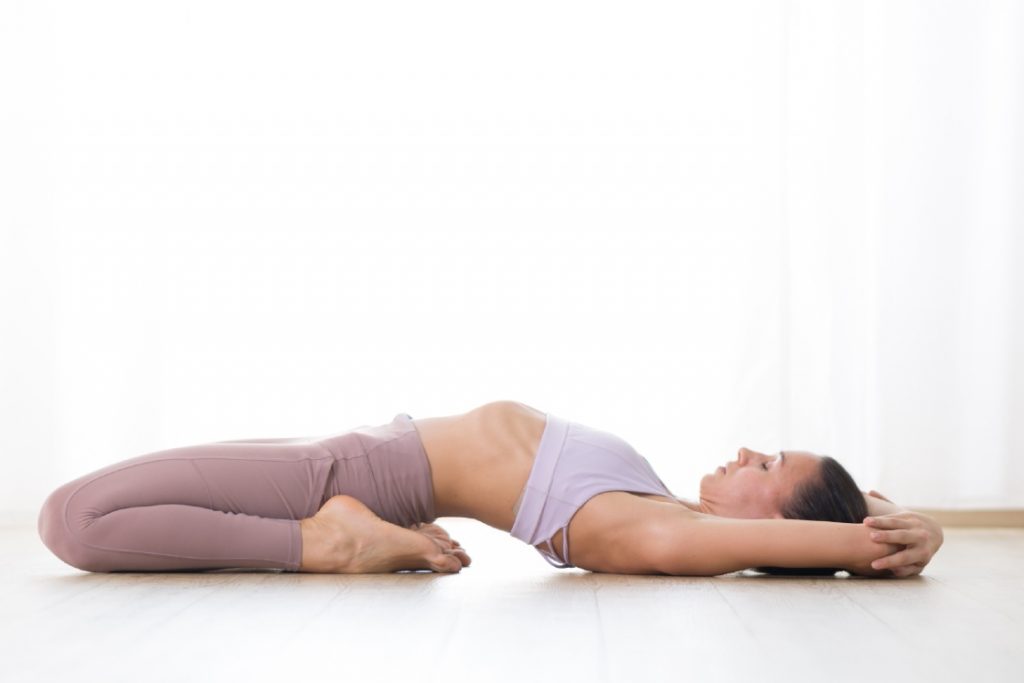
Vajrasana Ankle Stretch: This is an advanced variation of the traditional pose where you apply pressure and increase the stretch in the ankles. To perform this pose, hold your knees with your hands and pull your knees up, taking your torso back. Use the support of a wall to assist with the backward lean. You should be comfortable with ankle flexibility to practice this pose.
Vajrasana Twist: In this variation, instead of keeping your torso facing forward, you can twist the entire upper body, including your head sideways. Take one arm at the back and place the hand outside the feet to release stiffness from the shoulders. The twist will also give a deeper stretch to the back muscles as well as the spine. Your chest will also expand, increasing your lung capacity.
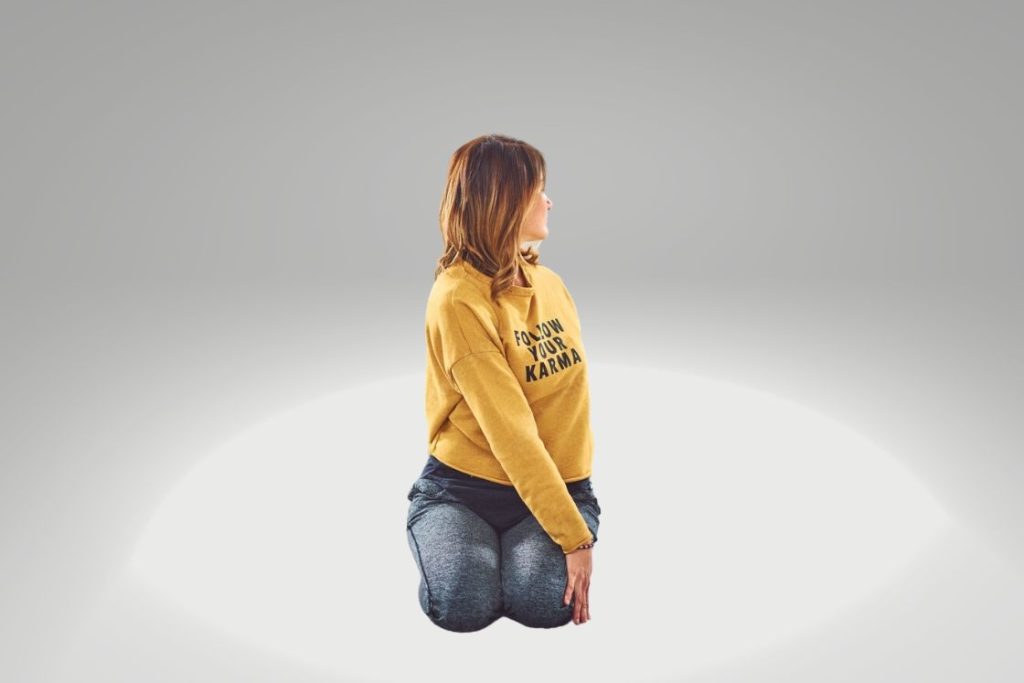
Modifications
Toe Squat – In this modified pose, instead of keeping the top of your feet flat on the ground, you keep the feet vertical. The balls of your feet rest on the ground and you sit on the heels. It directly impacts the ankles, heels, soles, and toes while increasing the stretch on the quads and hamstrings. This stretches the muscles of the soles of the feet, specifically the plantar fascia, thus, should be performed with caution.
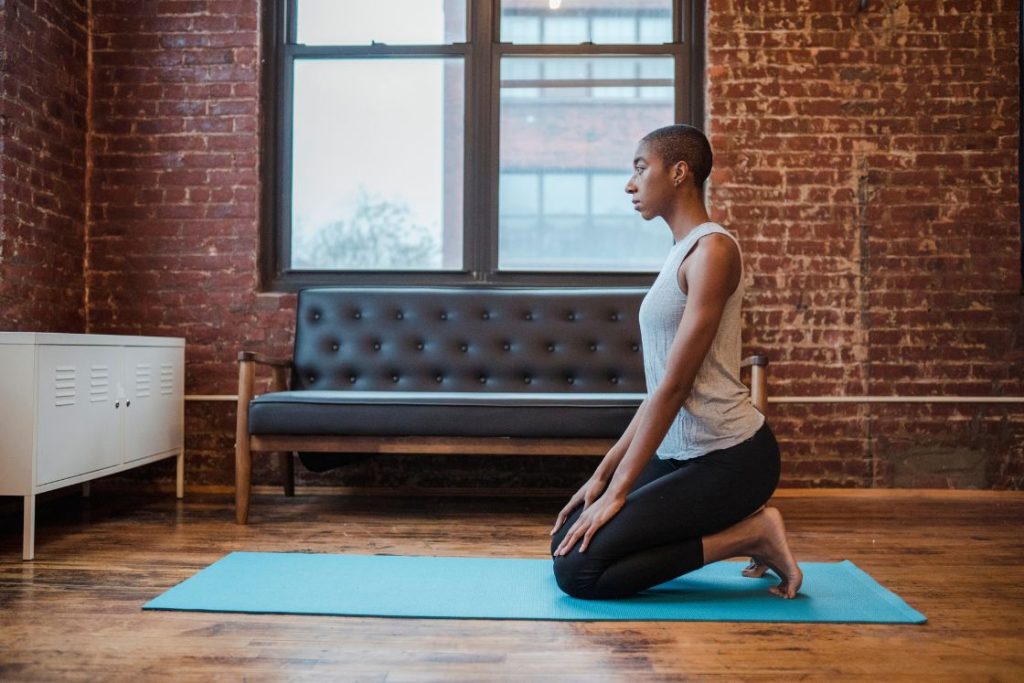
Reverse Namaste – While staying in the vajrasana position, take your hands behind your back and try making the anjali mudra or the namaste gesture at the back. This is a great way to open your chest and release stiffness from your shoulders.

Cow Face Arms – This is a milder variation of the Cow Face pose where you only practice the hand positioning of the pose to open your chest and strengthen your arms. To practice this, extend your right arm overhead and bend at the elbows to bring the forearms down, towards the back. Similarly, take your left arms backward and bend at the elbows so that the left palm is facing the back. Try and hold your hand or touch the fingertips at the back. This may be difficult at first but you can use props such as straps or towels to bridge the distance between the hands.
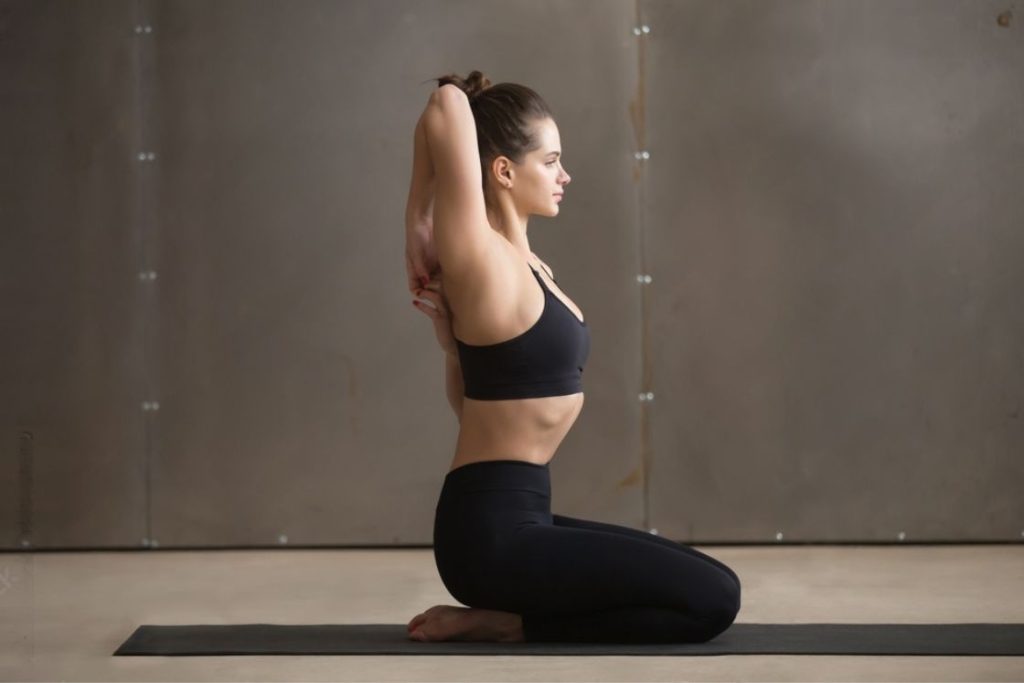
Follow-up Poses
Seated Forward Bend (Paschimottanasana)
Butterfly Pose (Baddhakonasana)
Half Lord of the Fishes Pose (Ardha Matsyendrasana)
Benefits of Vajrasana/Thunderbolt Pose
The simple-looking Vajrasana brings many benefits to the body, especially to the digestive system. It increases the digestive function of the body, resulting in good and soothing digestion. The back, chest, and center of the body are addressed by Vajarasana.
It can help relieve neck and back tension caused by constantly sitting at a desk. Vajrasana also stretches the chest and shoulders, allowing for effortless and flowing breathing patterns during meditation. When combined with meditation and pranayama, it helps improve mental clarity and relieve stress.
Below are some other benefits you can get from practicing Vajrasana.
- It improves the function of the digestive system
The upright posture of Vajrasana stimulates blood flow to the digestive organs. It promotes the optimal and effective functioning of the digestive system, which is why it can be performed after a meal. Better blood flow means better absorption of nutrients. Also, an optimally functioning digestive system means that there are fewer digestive problems such as hyperacidity, indigestion, flatulence, constipation, etc.
- Helps eliminate lower back pain
Sitting upright on your heels means that you tense your back muscles, focusing on the lower back muscles. This strengthens the muscles in that area, which helps relieve pain and stiffness.
This was also proven in a study published in 2010, where 12 volunteers practised Vajrasana along with other yoga asanas. It helped relieve lower back discomfort and pain.
Vajrasana can also help relieve pain related to the sciatic nerve.
- Can break down excess fat and help with weight loss
Vajrasana improves metabolism, which in turn improves the digestive system. An improved digestive system also helps with a better detoxification process. Toxins are removed from the body through excretion and perspiration, which can aid in the breakdown of body fat.
In addition, sitting upright requires you to tense your core muscles. The abdominal muscles are stimulated, toned, and firmed, which promotes the breakdown of excess abdominal fat.
- Promotes better prana flow by improving posture
By placing your buttocks on your heels, you promote proper posture of your lower spine. By aligning your spine perfectly, you will be encouraged to correct your hunchback. Proper posture is key to the free flow of prana through the body and spine. Improved prana flow helps heal the body from within and creates a pathway for better physical and mental well-being.
- Strengthens the lower body
This seated posture strengthens the pelvic muscles and improves the flexibility of the hip joints. It also stretches the thigh muscles and releases accumulated stress and stiffness. Bending the knee ensures that you gradually improve flexibility and increase your range of motion.
Positioning your feet also ensures that your ankles get the attention they need, eliminating persistent pain or stiffness. All of these factors help to reduce or eliminate rheumatic pain.
- Vajrasana also promotes blood flow to the liver, kidneys, and pancreas, improving their function and preventing the development of diabetes.
- Women who suffer from menstrual cramps or urinary incontinence, or who are pregnant, can benefit greatly from this posture, as it strengthens not only the pelvic muscles but also the muscles of the lower back.
- It helps the body and mind enter a meditative state and, when combined with deep yogic breathing, can help prevent anxiety, depression, and other psychological problems.
- Reducing negative emotions and feelings also contributes to restful and peaceful sleep.
- Doing it regularly along with pranayama and chanting will help you awaken the kundalini and promote its rise through the nadis and chakras.
Conclusion
Vajrasana is a popular choice for many individuals as it serves as both a standalone pose and a foundational element in various yoga asanas. With its simplicity and peacefulness, it is easily accessible for beginners to practice at home and experience the numerous health benefits. Incorporating Vajrasana into your yoga journey can serve as a wonderful starting point toward overall well-being.
FAQs Vajrasana( Thunderbolt Pose)
- Can anyone practice Vajrasana?
Vajrasana is generally suitable for people of all ages and fitness levels. However, people with knee or ankle injuries, hernias or ulcers should avoid this posture or seek advice from a qualified yoga instructor. It’s always important to listen to your body and practice within your comfort zone.
- How many times can I do Vajrasana in a day?
There is no fixed limit to how many times you can practice Vajrasana in a day. You can do it several times depending on your comfort and preference. However, it is recommended to listen to your body and avoid overexertion.
- How long can I sit in Vajrasana?
The duration of sitting in Vajrasana can vary according to comfort and flexibility. Beginners can start with a few minutes and gradually increase the duration as the body adjusts. However, it’s important to avoid excessive strain or discomfort and to increase stamina over time.
- Can Vajrasana be practiced after meals?
Yes, Vajrasana can be practiced after meals and is often recommended for better digestion. Sitting in Vajrasana after a meal for 5-10 minutes can improve digestion and decrease digestive issues. It is believed to improve the overall function of the digestive system.




